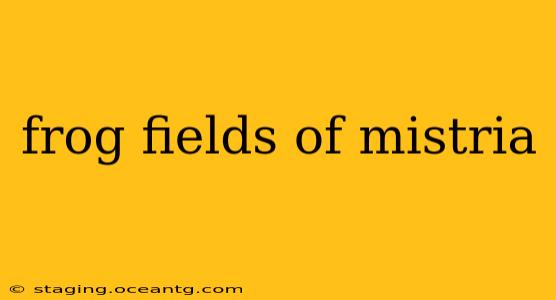The whimsical world of Mistria, often shrouded in a mystical mist, is home to a captivating array of creatures. But among its most fascinating inhabitants are the frogs of Mistria, found in sprawling, vibrant fields that play a crucial role in the region's delicate ecosystem. This exploration delves into the unique characteristics, ecological significance, and cultural importance of these amphibious wonders.
What Makes Mistria's Frog Fields Unique?
Mistria's frog fields aren't just random gatherings of amphibians; they are complex ecosystems characterized by specific environmental factors. These fields are typically located near freshwater sources, like slow-moving rivers or crystal-clear streams, providing essential breeding grounds. The unique microclimate, with its consistent moisture and moderate temperatures, is ideal for supporting a thriving amphibian population. The fields themselves are often composed of diverse vegetation, including moisture-loving plants, providing ample food and shelter for the frogs. The rich biodiversity of these fields supports a wide range of insect and invertebrate life, forming the base of the frog's food chain.
What Types of Frogs Inhabit the Mistrian Frog Fields?
Mistria's frog fields are home to a surprisingly diverse range of frog species, each with its own unique adaptations. While comprehensive documentation remains a work in progress for researchers, some notable species include:
-
The Gloomwing Frog: This elusive species is known for its dark coloration, which helps it blend seamlessly into the shadowed areas of the frog fields. Its nocturnal habits and unique vocalizations make it a challenging subject for researchers.
-
The Sunstone Frog: A vibrant, brightly colored frog, the Sunstone frog is often found basking in the sunlight on rocks and logs, its skin absorbing the warmth. Its striking appearance makes it a popular subject for artists and photographers.
-
The Whispering Reed Frog: This smaller species prefers the dense reed beds that border the frog fields, its calls resembling a gentle whisper carried on the breeze. Its camouflage is exceptional, making it almost invisible amongst the reeds.
Further research is needed to fully catalog the frog species of Mistria, hinting at the vast potential for discovery within these enchanting ecosystems.
What is the Ecological Role of Mistria's Frog Fields?
Mistria's frog fields play a vital role in maintaining the balance of the region's ecosystem. Frogs are significant predators of insects, helping to control populations of pests that could otherwise damage crops and spread disease. Their presence indicates the overall health of the ecosystem, acting as a bio-indicator of environmental quality. The decaying matter from the frogs and other organisms in the fields contributes to nutrient cycling, enriching the soil and supporting plant growth.
What are the Threats to Mistria's Frog Fields?
Despite their resilience, Mistria's frog fields face several threats:
-
Habitat Loss: Expansion of human settlements and agriculture are leading to the destruction and fragmentation of frog habitats.
-
Pollution: Runoff from agricultural lands and industrial areas contaminates water sources, harming frog populations.
-
Climate Change: Shifting weather patterns and increased temperatures can disrupt breeding cycles and survival rates.
-
Disease: Emerging infectious diseases can devastate frog populations, highlighting the vulnerability of these ecosystems.
Conservation efforts are crucial to protect these vital habitats and preserve the biodiversity of Mistria's frog fields.
Are Mistria's Frog Fields Important Culturally?
Mistria's frog fields hold cultural significance for the inhabitants of the region. Many folklore and legends feature the frogs, often depicting them as symbols of good luck, prosperity, or transformation. Local artisans frequently incorporate frog imagery into their artwork, reflecting the deep connection between the community and the natural world.
How Can We Protect Mistria's Frog Fields?
Protecting Mistria's frog fields requires a multi-faceted approach:
-
Habitat Restoration: Re-establishing degraded habitats and creating protected areas.
-
Pollution Control: Implementing stricter regulations to reduce pollution from agricultural and industrial sources.
-
Climate Change Mitigation: Reducing greenhouse gas emissions to help stabilize the climate.
-
Disease Monitoring and Management: Implementing surveillance programs and developing strategies to control disease outbreaks.
-
Community Engagement: Educating the local population about the importance of frog fields and engaging them in conservation efforts. This fosters a sense of ownership and responsibility for protecting these precious ecosystems.
The frog fields of Mistria represent a unique and valuable part of the region's natural and cultural heritage. Protecting these enchanting ecosystems requires a collective effort to ensure their survival for generations to come. Further research and dedicated conservation initiatives are vital to fully understand and safeguard the biodiversity within these magical landscapes.
